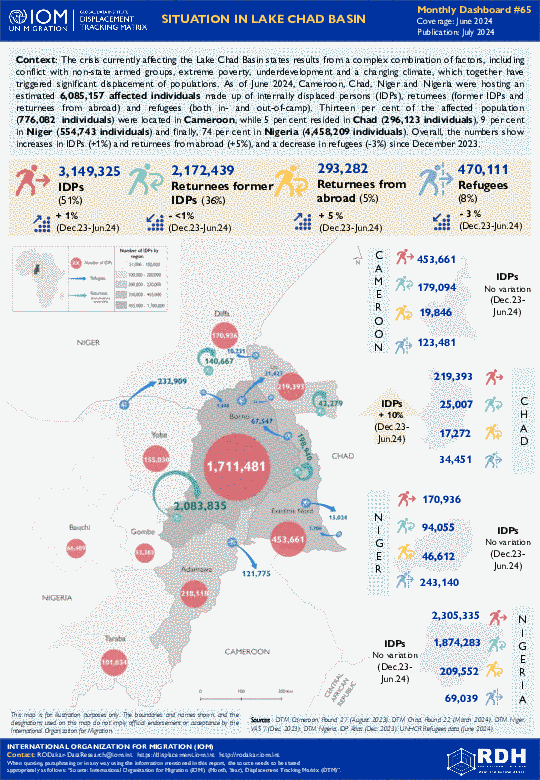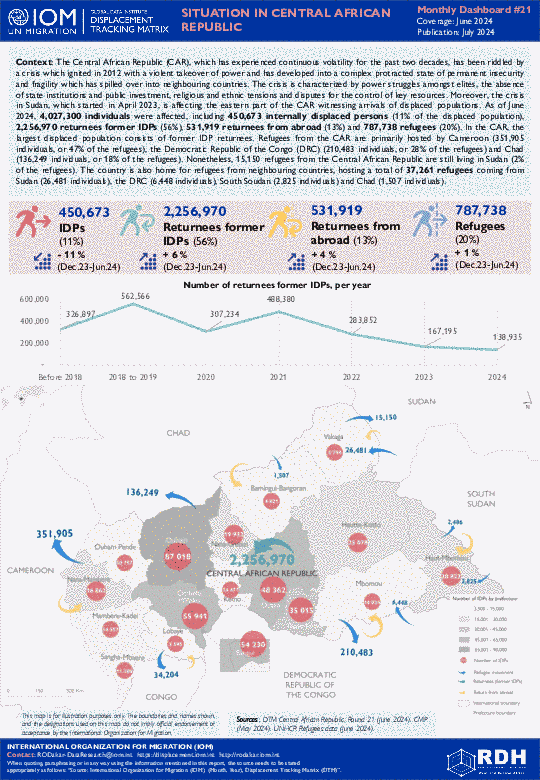-
Countries
-
Data and Analysis
-
Special Focus
-
Crisis Responses
Error message
The submitted value field_published_date_value in the Sort by element is not allowed.
The crisis currently affecting the Lake Chad Basin states results from a complex combination of factors, including conflict with non-state armed groups, extreme poverty, underdevelopment and a changing climate, which together have triggered significant displacement of populations.
As of June 2024, Cameroon, Chad, Niger and Nigeria were hosting an estimated 6,085,157 affected individuals made up of internally displaced persons (IDPs), returnees (former IDPs and returnees from abroad) and refugees (both in- and out-of-camp). Thirteen per cent of the affected population (776,082 individuals) were located in Cameroon, while 5 per cent resided in Chad (296,123 individuals), 9 per cent in Niger (554,743 individuals) and finally, 74 per cent in Nigeria (4,458,209 individuals). Overall, the numbers show increases in IDPs (+1%) and returnees from abroad (+5%), and a decrease in refugees (-3%) since December 2023.
The Central African Republic (CAR), which has experienced continuous volatility for the past two decades, has been riddled by a crisis which ignited in 2012 with a violent takeover of power and has developed into a complex protracted state of permanent insecurity and fragility which has spilled over into neighbouring countries. The crisis is characterized by power struggles amongst elites, the absence of state institutions and public investment, religious and ethnic tensions and disputes for the control of key resources. Moreover, the crisis in Sudan, which started in April 2023, is affecting the eastern part of the CAR witnessing arrivals of displaced populations.
As of June 2024, 4,027,300 individuals were affected, including 450,673 internally displaced persons (11% of the displaced population), 2,256,970 returnees former IDPs (56%), 531,919 returnees from abroad (13%) and 787,738 refugees (20%). In the CAR, the largest displaced population consists of former IDP returnees. Refugees from the CAR are primarily hosted by Cameroon (351,905 individuals, or 47% of the refugees), the Democratic Republic of the Congo (DRC) (210,483 individuals, or 28% of the refugees) and Chad (136,249 individuals, or 18% of the refugees). Nonetheless, 15,150 refugees from the Central African Republic are still living in Sudan (2% of the refugees). The country is also home for refugees from neighbouring countries, hosting a total of 37,261 refugees coming from Sudan (26,481 individuals), the DRC (6,448 individuals), South Soudan (2,825 individuals) and Chad (1,507 individuals).
Contact
dtmlebanon@iom.int
Location
Lebanon
Activity
- Mobility Tracking
- Baseline Assessment
Period Covered
Oct 10 2023 -Jun 25 2024
Since October 8 there has been an increase in cross-border incidents between Israel and Lebanon, resulting in the displacement of people both within the South and elsewhere within the country. Since October 10, the Displacement Tracking Matrix (DTM) has been conducting the daily monitoring of population movements. The objective of the exercise is to inform preparedness and response planning.
Population Groups
IDPs
Returnee (Previously Internally Displaced)
Survey Methodology
Unit of Analysis Or Observation
Admin Area 2
Admin Area 3
Household
Individual
Type of Survey or Assessment
Key Informant
Keywords
Geographical Scope Full Coverage
Administrative boundaries with available data
The current dataset covers the following administrative boundaries

Contact
DTM REMAP Support Team (dtmremapsupport@iom.int); MTM Tajikistan (mtmtajikistan@iom.int)
Language
English
Location
Tajikistan
Period Covered
Feb 27 2024
Apr 26 2024
Activity
- Survey
- Baseline Assessment
Mobility Tracking Matrix (MTM) implements the Baseline Mobility Assessment (BMA) in Tajikistan to track mobility, provide information on population estimates, geographic distribution of migrant workers and return migrants, reasons for migration and countries of return. Data is collected at the village level from key informants and direct observations.
The Baseline Mobility Assessment (BMA) was conducted in all five provinces in 12 districts/cities of Tajikistan (including Ismoili Somoni, Sino, Firdawsi, Shohmansur districts of Dushanbe city, Vahdat city, Rudaki district of Districts of Central Subordination, Khujand city of Sughd region, Bokhtar, Kulob cities and Panj district of Khatlon region, Khorugh city and Vanj district of Gorno-Badakhshan Autonomous Oblast (GBAO). This assessment covered 935 communities through interviews with 3,459 key informants. Based on the key informants' estimates, 4,010 international migrant workers were hosted in the assessed communities in Tajikistan during 2020 and April 2024. Concurrently, 3,133 internal migrants were hosted in the assessed communities and 271,059 Tajik nationals were reported to be residing abroad as international migrants. In addition, 299,834 return migrants have returned from abroad.

Contact
DTM Ethiopia, DTMEthiopia@iom.int
Language
English
Location
Ethiopia
Period Covered
Feb 15 2024
Feb 29 2024
Activity
- Survey
- Displacement Solutions
This report presents findings on data collected by the IOM Data and Research Unit (DRU) through its DTM methodology and Household-Level Survey (HLS) tool. The objective of this HLS is to measure parity between Internally Displaced Persons (IDPs) and non-displaced residents and assess IDPs’ progress towards durable solutions in the Somali region of Ethiopia. The survey took place in Dawa, Doolo, Nogob and Shabelle zones. The data allows the identification of gaps for more targeted interventions to support the attainment of durable solutions.
While local integration was the preferred durable solution for IDPs in the four assessed zones, as it can be seen from the analysis of the results of the assessment, various factors including displacement status might be hindering access to services and participation, which ultimately impacts the ability of IDP households to progress towards a durable solution through local integration.

Contact
DTM Support — iomdrcdtm@iom.int
Language
French
Location
Democratic Republic of the Congo
Period Covered
Mar 29 2024
Apr 26 2024
Activity
- Mobility Tracking
- Event Tracking
Ce tableau de bord présente les principaux résultats de suivi des mouvements de populations dans la province de l’Ituri à l’issue du onzième round d’évaluation conduit par l’unité de la Matrice de Suivi des Déplacements (Displacement Tracking Matrix, en anglais (DTM)) de l’Organisation Internationale pour les Migrations (OIM). Ces évaluations ont été réalisées à travers un exercice de collecte de données conduit du 29 mars au 26 avril 2024, en collaboration avec l’ONG locale, Réseau d’Action pour le Développement et le Progrès Intégré (RADPI), et la Commission Nationale pour les Réfugiés (CNR). Lors de ce cycle, un total de 6 529 villages, couvrant 36 zones de santé (ZS), ont été évalués à travers des consultations avec 17 166 informateurs clés.

Contact
DTM Libya, DTMLibya@iom.int
Language
English
Location
Libya
Snapshot Date
Jun 30 2024
Activity
- Survey
- Flow Monitoring Survey
- Flow Monitoring
This profile provides information on the most recent migration dynamics between Niger and Libya as well as the sociodemographic characteristics and vulnerabilities of Nigerien migrants in Libya, including their level of access to healthcare and employment conditions.
Grenada
IDPs tracked
Displacement Movements
No figure is available
IDMC 2023
Data collection round
Saint Vincent and the Grenadines
IDPs tracked
Displacement Movements
No figure is available
IDMC 2023
Data collection round
Jamaica
IDPs tracked
Displacement Movements
No figure is available
IDMC 2023
Data collection round




